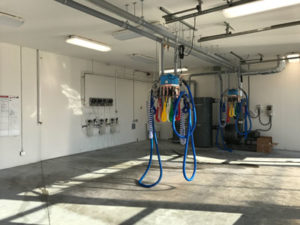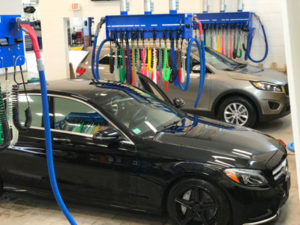Dealers Turn Detail Departments Into Revenue Sources

For too long, the in-house detail departments of new car dealerships have dragged down profit. Yet auto detailing is essential not only to get vehicles into pristine salable condition, but also to earn strong customer satisfaction reviews. One reason for this financial drain has been the industry’s typically disorganized, nonstandardized approach to detailing, which results in an unnecessarily high cost of labor, chemicals, and materials with slower turnaround and lower quality work.
Now, however, top dealers are taking a page from the auto industry’s lean production techniques. They are managing equipment, personnel, and materials to optimize productivity, workflow, and quality while minimizing waste. By doing so, they are transforming their detailing operations from a profit drain into a revenue source. Such an approach can supply superior quality detailing and cut 25% or more of the time and labor needed to ready a vehicle for the lot. It can also save several dollars per vehicle in chemical and material costs for approximately a one-year ROI.
“We have essentially cut our detailing time in half and improved the quality using lean production techniques,” says Chris Davis, Detail Manager at Wagner Auto Group, a full service new and used dealer of BMW, Audi, Mercedes, and Kia vehicles in Shrewsbury, Massachusetts. “Superior detailing has become a sales advantage because impeccably clean cars sell and dirty ones do not.”
Traditional inefficiency
“While auto detailing thoroughly cleans, restores, and finishes the vehicle’s interior and exterior to show-quality cleanliness and polish, the traditional process costs about $100 including several man hours of labor and about $10 in chemicals and materials before the vehicle is ready for sale on the lot,” says R.L. Abraham, President Emeritus of Detail Plus Car Appearance Systems, a Dallas, Texas-based manufacturer of car detailing equipment.
Yet the quality of the detailing is often poor due to a lack of a standardized process, materials, and management. Most detailing operations accumulate and store the required equipment, supplies, and chemicals in a disorganized manner. Spray bottles, chemicals, buffers, pads, and materials may be in different locations, requiring detailers to leave the service bay to retrieve the items before work can proceed.
The detailing steps may be followed, but often not in a systematic order. Furthermore, the process is usually inconsistent, with chemical concentrations varying depending on how much of each chemical is put in the bottle and who is diluting it. Too much time is wasted filling bottles, mixing chemicals, looking for this, waiting for that. Chemical and supply costs also increase due to spills and theft in such operations.
Davis says that previously Wagner Auto Group’s detail department spent too much time mixing chemicals, refilling spray bottles, and chasing down materials and equipment. “Downtime does not make dealerships money, so the less time spent locating and setting up detailing equipment and materials the better,” says Davis. When several hundred new and used vehicles may need to be detailed every month per dealership to ready vehicles for sale, inefficient detailing can seriously depress profits.
Greater efficiency
Following the lead of the auto industry’s implementation of lean production, popularized by the Toyota Production System, top auto dealers are now learning how to cut the waste from their detailing operations while optimizing workflow, quality, turnaround, and customer value. This is turning previously unprofitable detail operations into revenue sources.

“What this approach requires is organizing and controlling the detailing process via centralized stations that anticipate every need and puts it all at the fingertips of the person doing the work,” says Abraham. “This includes the organization of materials at fully supplied workstations with controlled chemical delivery and dilution, along with racks and carts.” One example of this approach that is gaining ground among dealers involves the use of ChemSpense workstations by Detail Plus, which put all the tools and supplies needed by detailers within easy reach so they never have to leave the vehicle or service bay.
These are placed on both sides of the vehicle to allow more than one person to work independently at the same time. This increases productivity so more vehicles are detailed per day, and the vehicles get to the lot faster ready for sale. When Wagner Auto Group recently set up a new detailing facility with Detail Plus’s assistance, it included eight ChemSpense workstations along with a variety of other equipment. The workstations dispense up to 12 necessary cleaners, shampoos, and treatments through color coded, chemical lines, eliminating the waste, distraction, and mess associated with squeeze and spray bottles.
Even more viscous chemicals, such as waxes, polishes, and compounds, are dispensed through the system, which further expedites the paint finishing process.
“Everything is ready right where you need it so there is no wasted time or effort,”
says Davis.
“With two techs working on a vehicle, we can essentially detail the interior and buff and wax the exterior in approximately 30-45 minutes per car.” Because each workstation includes a powerful wet/dry vacuum, this eliminates the need for clumsy portable shop vacuums. “Our detailers do not have to drag around shop vacuums between vehicles, so there is no worry about bumping them,” says Davis.
For cleaning and shampooing carpets and fabric upholstery, each workstation has an internal heated soil extraction system. Two coiled air lines are also available for operating pneumatic tools such as buffers, shampooers, and orbital waxers, as well as to blow dust and dirt out of hard to reach places. “We use one airline to blow dust out of the small cracks and crevices, and the other airline for pneumatic tools like buffers and carpet scrubbers,” says Davis.

One key to making the system much more efficient than traditional shops using spray bottles is an accompanying Chemical Dilution and Dispensing System. This chemical distribution center automatically dilutes all water-based chemicals to exact proportions, which improves safety and quality while eliminating chemical waste and improper mixing.
All chemicals, including ready-to-use products, are delivered to the workstations installed in the detailing center. “The chemical dispensing system is essentially foolproof and ensures that we get consistent quality formulations for our details,” says Davis.
“We also save at least several dollars per vehicle by avoiding spills, improper mixing, and other waste.” Compact, moveable detail work carts are another aspect of the system that are critical to dealer efficiency. The work carts provide detailers with instant access to buffing pads, tools, towels, and supplies as well as provide detachable bins to deposit refuse and dirty towels. “Once our detailers load their work carts from our central storage area, they have everything they need for the day,” says Davis.
Greater profitability
The bottom line for dealers looking to transform their detailing from a necessary evil into an actual profit center is enabling everyone, including technicians and managers, to work smarter, not harder.
“With our ultra efficient detailing process, we can now take a dirty car from the lot, get it prewashed, prepped, detailed, photographed, and put back on the lot ready for in person and online sales in an hour,” says Davis.
“We estimate one-year ROI on the detailing equipment,” concludes Davis. “It is already helping to generate word of mouth sales as our retail customers, impressed by the superior detailing, refer friends and family.”
For more info, call 503-251-2955; email detailplus@detailplus.com; visit www.detailplus.com; or write to DETAIL PLUS Car Appearance System at 527 S. Dooley St, Grapevine, TX 76051.
Tags:
authored by
Press Release
Get Curated Insights
Content worth the click
Related Articles












